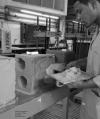Abstract
Currently there is a high level of ignorance in what respects rehabilitation and conservation of earth buildings. It is necessaryto use a mortar compatible with these kinds of supports. Therefore, it is essential to understand the behaviorof earth mortars. It is known that the amount of water used in mixing has great influence on physical characteristics,workability and consequently, application -particularly with the presence of clays.With the objective of filling up the knowledge void, characterization tests were performed on fresh and hardened earthmortars, with four different earths, in which six different water levels were added. Another objective is to directly assessthe workability through applications that were made by masons in rammed earth samples. After analyzing theresults it was observed that the shrinkage and workability are strongly influenced by the water/dry material, affectingthe viability of a mortar. However, the mason is a highly important factor in its application of a mortar.Apuntes is registered under a Creative Commons Attribution 4.0 International Public License. Thus, this work may be reproduced, distributed, and publicly shared in digital format, as long as the names of the authors and Pontificia Universidad Javeriana are acknowledged. Others are allowed to quote, adapt, transform, auto-archive, republish, and create based on this material, for any purpose (even commercial ones), provided the authorship is duly acknowledged, a link to the original work is provided, and it is specified if changes have been made. Pontificia Universidad Javeriana does not hold the rights of published works and the authors are solely responsible for the contents of their works; they keep the moral, intellectual, privacy, and publicity rights.
Approving the intervention of the work (review, copy-editing, translation, layout) and the following outreach, are granted through an use license and not through an assignment of rights. This means the journal and Pontificia Universidad Javeriana cannot be held responsible for any ethical malpractice by the authors. As a consequence of the protection granted by the use license, the journal is not required to publish recantations or modify information already published, unless the errata stems from the editorial management process. Publishing contents in this journal does not generate royalties for contributors.

